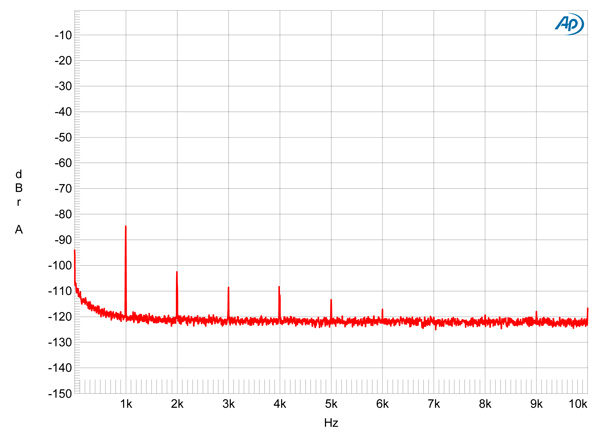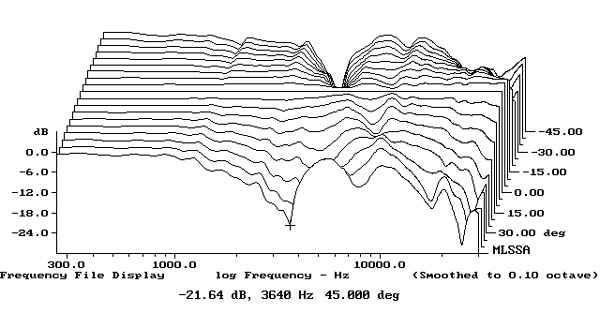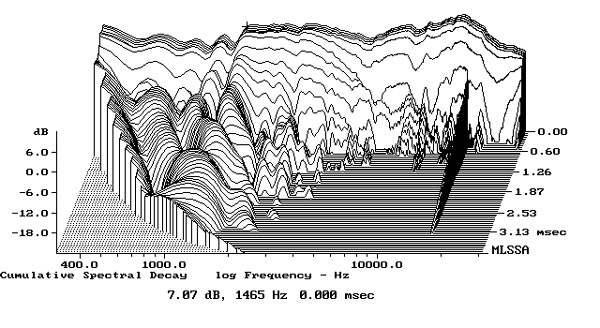| Columns Retired Columns & Blogs |
What kind of connection are you using for the ipod - simply through the headphone jack or is there a better way to connect to these speakers?
When Robert J. Reina reviewed the Audioengine A2 powered loudspeaker in the December 2007 issue, he concluded, "I have never been more impressed with or more stunned by a component I've reviewed for Stereophile than I was with the Audioengine 2. The level of sound quality produced by this uncolored, detailed, articulate, and dynamic speaker, in all situations, was beyond reproach, and its ratio of value to cost borders on the criminal."
I, too, was impressed. I bought a pair of the tiny A2s—each measures just 6" H by 4" W by 5.25" D—to use in our kitchen TV system, where they've done sterling service ever since, hooked up to the headphone output of a Samsung flat-panel TV. My only quibble was that the bass boost the A2 uses to squeeze enough low frequencies out of its woofer, which has a Kevlar cone just 2.75" in diameter and a rubber half-roll surround, makes the speaker intolerant of positioning close to room corners, where it sounds hooty.
At the end of 2013, Audioengine replaced the A2 with the A2+ (footnote 1). This appears to be identical to the A2, but adds to the left, master speaker a USB 1.1 input for digital audio and a pair of output jacks, used to feed an unfiltered, unequalized signal to a subwoofer(s). (The right speaker in each pair is a conventional passive type; the left contains the amplifiers for both channels, the volume control, left and right input RCA jacks, a 3.5mm stereo input jack, and a pair of output terminals to feed the other speaker.) The tweeter is still a ¾" (20mm) silk-dome unit, the internal amplifier still a 15Wpc monolithic analog type. The price has increased from $199 to $249/pair.
Stephen Mejias had originally intended to write about the A2+ in his column, "The Entry Level," but left the magazine before being able to do so. When I finally got around to trying them out, I couldn't get any sound, from either the USB port or the line inputs. I asked for replacement samples. (The original samples had the serial number 13052000078W, the replacements 14011509708B.)
Before I performed any measurements, I compared the A2+s with my pair of original A2s. The two pairs of Audioengines sounded identical, and when I listened critically to the new versions, driven by Pono's PonoPlayer (reviewed elsewhere in this issue) and with the A2+s set up on 24"-high stands, I was impressed by how well these tiny speakers managed to fill my listening room with sound. No, they didn't play at head-banging levels, but with both classical chamber music and well-recorded rock they sounded clear and clean. Low bass was missing in action, of course, but in free space, the upper bass was in good balance with the midrange. The bass in "There Ain't No Sweet Man That's Worth the Salt of My Tears," from Diana Krall's Glad Rag Doll (24-bit/96kHz ALAC file), lacked body but still sufficiently supported the music. Krall's husky voice had a slightly woody coloration, though this was relatively mild in degree. The top octave lacked some air.
Once I'd listened to the new speakers and confirmed that their sound quality lived up to Bob Reina's evaluation of the originals, I took them into the test lab. To examine their behavior via USB, I used my 2012-vintage MacBook Pro, running on battery power. The Mac USB Prober utility reported that the Audioengine A2+'s USB port operated in the usual isochronous adaptive mode, and that it would accept 16-bit data with sample rates of up to 48kHz. This is what I'd expected, given that the speaker uses the TI/Burr-Brown PCM2704C USB receiver/DAC chip. The Manufacturer string was reported as "Audioengine," the Product String as "Audioengine 2+," and the Device Vendor ID as "Texas Instruments Japan."

With the volume control at its maximum, a full-scale digital signal via USB gave a level at the right-speaker output terminals of 9.823V, equivalent to 12W into 8 ohms. The only digital-domain test I performed was to examine the DAC's resolution. Fig.1 is a spectral analysis taken at the speaker terminals while the speaker decoded 16-bit data representing a dithered 1kHz tone at –90dBFS. The tone is reproduced 5dB too high in level, and some low-level, low-order harmonics can be seen. The noise floor lies between the 14- and 15-bit level, which again is what I would expect from the PCM2704C DAC chip.
In the analog-domain tests, the A2+'s line input impedance of 4.5k ohms was lower than that of both the original speaker and the specified 10k ohms. The line input preserved absolute polarity (ie, was non-inverting), and the maximum gain was 27.6dB, which is on the high side.

The passive, right speaker had an estimated sensitivity of 83dB(B)/V/m, and its impedance remained between 4 and 10 ohms through most of the audioband (fig.2). The magnitude saddle centered on 65Hz in fig.2 suggests only modest low-end extension, though the low height of the lower-frequency peak suggests that the alignment is more overdamped than in the A2.

The red trace in fig.3 shows the internal amplifier's frequency response, taken at the speaker output terminals. As in the A2, a modest, 4.7dB boost centered on 80–100Hz is used to extend the acoustic output in the midbass, though this will reduce the dynamic range at low frequencies. This boost was independent of the volume-control setting. The blue trace in this graph is the response at the output RCA jacks. No equalization is applied.

For the acoustic measurements, I used DRA Labs' MLSSA system and a calibrated DPA 4006 microphone to measure the Audioengine A2+'s frequency response in the farfield, and an Earthworks QTC-40 for the nearfield responses. The A2+'s farfield response on the tweeter axis (fig.4 above 300Hz) is identical to the A2's: impressively flat and extended in the treble, though with the upper midrange shelved down by up to 5dB. The rise in measured output below 400Hz will be partly due to the nearfield measurement technique, but mainly reflects the equalization shown in fig.3. The individual responses of the woofer (blue trace) and port (red) are shown, scaled in the ratio of the square roots of the radiating areas. I have shown the port's output only up to 300Hz; above that frequency, the measurement was affected by leakage from the woofer. The black trace in the bass is the sum of the port and woofer outputs, taking into account acoustic phase; even with the equalization, the A2+ rolls off below 120Hz or so.


Fig.5 shows the A2+'s lateral dispersion, normalized to the tweeter-axis response. As with the A2, there is a slight flare at the bottom of the tweeter's passband, due to the on-axis depression filling in to the speaker's sides. The tweeter's dispersion in the top octave is restricted, which explains why I found the sound lacking a touch of top-octave air. In the vertical plane (fig.6), a suckout develops in the crossover region more than 5° above the tweeter axis. To get the most neutral tonal balance from this speaker, be sure to listen on or below the tweeter axis.


The A2+'s step response on the tweeter axis (fig.7) indicates that both drivers are connected in positive acoustic polarity. While the cumulative spectral-decay plot (fig.8) is clean in the treble, there is some delayed energy associated with the upper-midrange step in the frequency response.
My experience of the + version of the Audioengine A2 was pleasant indeed—sufficiently so that I will reinstate it in "Recommended Components," which appears elsewhere in this issue. A heck of a speaker at a heck of a price!—John Atkinson
Footnote 1: The A2+ costs $249/pair in black or white.

What kind of connection are you using for the ipod - simply through the headphone jack or is there a better way to connect to these speakers?

This Stereophile review of the Audioengine A2's is very often referenced as the reason why many people bought the speakers, and it's easy to see why. The review is so enthusiastic that it almost reads like a passionate love letter, with the reviewer practically foaming at the mouth about how wonderful these speakers are.
For the most part, I agree with how good these speakers sound, but with one glaring exception. The review did not mention a word about the obviously excessive bloat of the bass at around 180Hz, which is about 6 dB too prominent and ruins the sonic signature. The bass bloat overshadows the rest of the frequency ranges and makes the speakers sound muddy and congested. 6 dB of bass bloat is not something you can just overlook--that is considered pretty severe coloration by the standards of audiophiles or pro audio. I for the life of me cannot understand why Robert J. Reina did not warn the readers about it--in fact, he vouched for how natural, accurate, and tight the bass was. So, either he has no idea what accurate/neutral/natural bass actually sounds like, or he chose not to talk about that flaw--either way, it makes me think twice about the credibility of Stereophile and its reviewers.

I agreed with Lunatique. I have a chance to place Audioengine A2 and Focal Book XS side by side for a comparison. A2 had a lot of bass, in fact, the bass was more than Focal's, and it also goes deeper(louder at 45hz); which is amazing for a much smaller speaker. BUT, it sounds not as good. In fact, the mid range was pretty muddy, lack lots of details; I would suspect there's an echo-plugin enabled for the vocals on A2s. The high's better than the mids, but still, it offered A LOT less detail and clarity than the Book XS. I feel that A2 sounded like watching an old SDTV; and XS was something between an HDTV and opening a window.
This speaker in my hand is definitely not "no coloration". Is it sound natual, yes, but it's somewhat muddy, warm, and tube like. It's enjoyable, just so different from what the review said here.

The reviewer is comparing a low end product with the likes of Audio Research amplification. One wonders if that is the right approach.

I've been using my AEGO 2 for years. The volume control is shot, often turning off the left channel. I considered the AEGO M but, of course, these are no longer available in the US. AE offered to send me an AEGO M (for $400) from UK which, they said, would work with a simple 220 to 120 volt converter.
Bottom line is that I need a decent, inexpensive powered speaker replacement to work with my iMac in a very small room. Best if they could be wall mounted and if they would have a separate input from my NAD CD player C 515BEE. (The AEGO 2 works with the NAD if I just unplug the subwoofer connection from the iMac) Choices seem to be Focal XS Book vs. Audioengine 2.
I would appreciate any input.
Best,
Marv

I really hate that the audio industry has turned into a lot of misrepresentations. It is done almoot reflexively at this point. From the Audioengine website FAQ:
"How can such small speakers have so much clean-sounding, deep, tight bass?
.... It's also worth mentioning that we don’t use any enhancement circuits to add fake bass, so what you’ll hear is real bass, really low and clean."
This review:
"As in the A2, a modest, 4.7dB boost centered on 80–100Hz is used to extend the acoustic output in the midbass, though this will reduce the dynamic range at low frequencies."
This is the definition of an enhancement circuit. I emailed Audioengine for clarification. No response. I owned the A2 and that bass bump was 6dB and it ruined the sound of that speaker, for anyone who is serious at this hobby.
Lies and more lies.